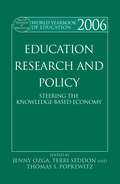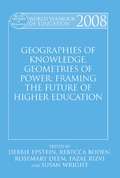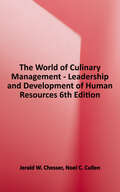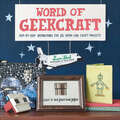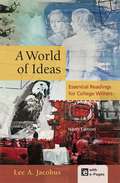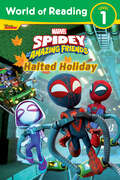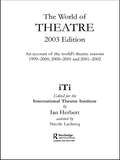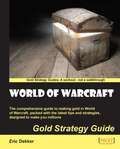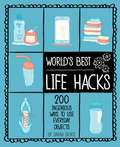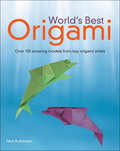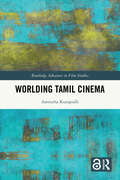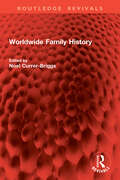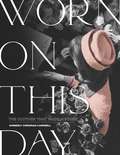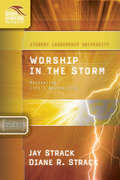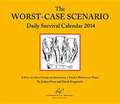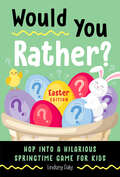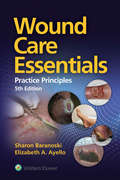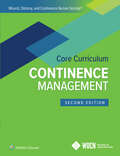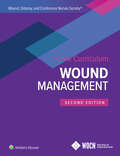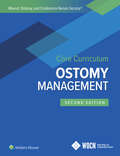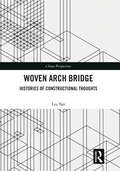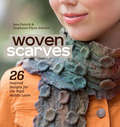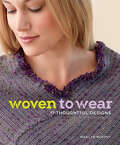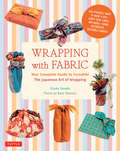- Table View
- List View
World Yearbook of Education 2006: Education, Research and Policy: Steering the Knowledge-Based Economy (World Yearbook of Education)
by Thomas S. Popkewitz Terri SeddonThis volume considers the ways in which educational research is being shaped by policy across the globe. Policy effects on research are increasingly influential, as policies in and beyond education drive the formation of a knowledge-based economy by supporting increased international competitiveness through more effective, evidence-based interventions in schooling, education and training systems. What consequences does this increased steering have for research in education? How do transnational agencies make their influence felt on educational research? How do national systems and traditions of educational research - and relations with policy - respond to these new pressures? What effects does it have on the quality of research and on the freedom of researchers to pursue their own agendas? The 2006 volume of the World Yearbook of Education explores these issues, focusing on three key themes: globalising policy and research in education steering education research in national contexts global-local politics of education research. The 2006 volume has a truly global reach, incorporating transnational policy perspectives from the OECD and the European Commission, alongside national cases from across the world in contrasting contexts that include North and South America, Canada, France, Singapore, China, Russia and New Zealand. The range of contributions reflect how pervasive these developments are, how much is new in this situation and to what extent evidence-based policy pressures on research in education build on past relationships between education and policy. This book considers the impact of the steering processes on the work and identities of individual researchers and considers how research can be organised to play a more active role in the politics of the knowledge economy and learning society.
World Yearbook of Education 2008: Geographies of Knowledge, Geometries of Power: Framing the Future of Higher Education (World Yearbook of Education #Vol. 2008)
by Susan Wright Debbie Epstein Fazal Rizvi Rosemary Deem Rebecca BodenThis volume examines higher education in globalized conditions through a focus on the spatial, historic and economic relations of power in which it is embedded. Distinct geometries of power are emerging as the knowledge production capability of universities is increasingly globalized. Changes in the organization and practices of higher education tend to travel from the ‘West to the rest’. Thus, distinctive geographies of knowledge are being produced, intersected by geometries of power and raising questions about the recognition, production, control and usage of university-produced knowledge in different regions of the world. What flows of power and influence can be traced in the shifting geographies of higher education? How do national systems locate themselves in global arenas, and what consequences does such positioning have for local practices and relations of higher education? How do universities and university workers respond to the increasing commodification of knowledge? How do consumers of knowledge assess the quality of the ‘goods’ on offer in a global marketplace? The 2008 volume of the World yearbook addresses these questions, highlighting four key areas: Producing and Reproducing the University— How is the university adapting to the pressures of globalization? Supplying Knowledge—What structural and cultural changes are demanded from the university in its new role as a free market supplier of knowledge? Demanding Knowledge—Marketing and Consumption—How can consumers best assess the quality of education on a global scale? Transnational Academic Flows—What trends are evident in the flow of students, knowledge and capital, with what consequences? The 2008 volume is interdisciplinary in its approach, drawing on scholarship from accounting, finance and human geography as well as from the field of education. Transnational influences examined include UNESCO and OECD, GATS and the effects of digital technologies. Contrasting contexts include Central and Eastern Europe, Finland, China and India and England. With its emphasis on the interrelationship of knowledge and power, and its attention to emergent spatial inequalities, Geographies of Knowledge, Geometries of Power: Framing the Future of Higher Education provides a rich and compelling resource for understanding emergent practices and relations of knowledge production and exchange in global higher education.
World of Culinary Management, Leadership and Development of Human Resources, Sixth Edition
by Jerald W. Chesser Noel C. CullenA broad, all-encompassing look at the chef as a manager, examining the roles of leadership, management, training, and supervision. The World of Culinary Management: Leadership and Development of Human Resources, 6/e, one of the only texts designed for human resource management from a culinary perspective, gives aspiring chefs the foundational knowledge and skills required to lead, supervise, and manage food service workers. It outlines in clear terms those elements crucial to success in today's quality-driven foodservice industry, with an in-depth exploration of the roles and responsibilities of a successful food service manager. The text examines all aspects of training, providing practical discussions on essential management skills and functions. The new edition incorporates new time-sensitive information about issues such as the Affordable Care Act, diversity, and addresses women culinary industry leaders.
World of Geekcraft: Step-by-Step Instructions for 25 Super-Cool Craft Projects
by Susan BealA do-it-yourself instruction guide to creating collectible crafts from the worlds of science fiction, fantasy, and gaming. Geek meets craft in this fun collection of twenty-five kooky projects for geeks of any affiliation, from Dungeons & Dragons dice earrings, Star Trek pillows, and Super Mario cross-stitch to Star Wars terrariums, a Morse code quilt, and much more! Organized by difficulty from &“Not a Jedi Yet&” to &“Warp Speed,&” World of Geekcraft covers a range of popular crafting techniques including beading, quilting, appliqué, embroidery, and needle felting. Best of all, it&’s easy to get started with step-by-step instructions and handy templates included in the back of the book. With lots of photos and plenty of geekery throughout, this one-of-a-kind book shows that geek and craft go together like . . . pixels and cross-stitch!
World of Ideas: Essential Readings for College Writers (9th Edition)
by Lee A. JacobusThe first and bestselling reader of its kind, A World of Ideas introduces students to great thinkers whose ideas have shaped civilizations throughout history. When students hear names like Aristotle, Martin Luther King, Jr., or Sigmund Freud, they recognize the author as important — and they rise to the challenge of engaging with the text and evaluating it critically. No other composition reader offers a comparable collection of essential readings along with the supportive apparatus students need to understand, analyze, and respond to them.
World of Reading: Spidey and His Amazing Friends: Halted Holiday (World of Reading)
by Steve BehlingTeam Spidey works together to clear up traffic in this 32-page level 1 reader that relives the excitement of Spidey and His Amazing Friends holiday episode.When Miles' abuela gets stuck in the tunnel on her way to Thanksgiving dinner, Team Spidey swings into action to unblock the roads so families can be together for this traditional holiday meal. Super Hero fans can&’t miss this heartfelt 32-page story featuring Spidey and his amazing friends. With familiar words, simple sentence structures, and clear illustrations, Spidey&’s latest adventure is perfect for beginning readers. Explore Disney's World of Reading series, which provides emerging readers with books that inspire and excite them, featuring characters they love. Each level is designed to help readers navigate the wonderful world of reading at just the right pace.Read about more of Team Spidey's amazing adventures in these books!Spidey and His Amazing Friends: Construction DestructionSpidey and His Amazing Friends: Team Spidey Does it All! Comic ReaderSpidey and His Amazing Friends: Panther PatienceSpidey and His Amazing Friends: Meet Team SpideyWorld of Reading: Spidey Saves the DayWorld of Reading: Super Hero Hiccups
World of Theatre 2003 Edition: An Account of the World's Theatre Seasons 1999-2000, 2000-2001 and 2001-2002
by Ian HerbertEdited by Ian Herbert, President of the International Association of Theatre Critics, Secretary of the Drama Section of the Critics' Circle in London, and editor of Theatre Record, the chronicle of the British stage, and Nicole Leclercq, Archives et Musée de la Littérature, Brussels, the World of Theatre is a lavishly illustrated biennial publication providing on-the-spot and authoritative surveys of current theatrical activity from across the globe. The content of the book is as varied as the theatrical situations it describes, from magisterial round-ups by leading critics in Europe to desperate and pitiful reports from the battlefield in war-torn countries.With expanded coverage, this new edition encompasses the three seasons from 1999 to 2002 and contains articles from over seventy countries. The contributors include leading commentators such as Jim O'Quinn, editor of American Theatre, and England's Peter Hepple, the longest serving London theatre critic and a former editor of The Stage.The World of Theatre will be welcomed by theatre scholars as an ongoing revision of another Routledge reference work, the World Encyclopedia of Contemporary Theatre and is essential reading for anyone seeking up-to-date information on the developments in the leading theatre nations as well as those countries whose theatre is little known outside their boundaries.
World of Warcraft Gold Strategy Guide
by Eric DekkerRich with examples, detailed breakdowns, and step-by-step instructions, this book gets down to the nuts and bolts of gold making, to help you become a World of Warcraft gold tycoon.This book is for every World of Warcraft player who's tired of scrapping for gold or has ever wanted to be the one showing off expensive items in town.
World's Best Life Hacks: 200 Ingenious Ways to Use Everyday Objects
by Sarah DevosQuick tips and fun workarounds to solve problems large and small! Did you know that you can turn a bag of chips into a bowl in an instant? Or that you can peel a mango with a glass? Make a speaker with a toilet roll and two plastic cups? This is a collection of 200 clever and useful life hacks, with pictures included, for your home, garden, kids, and much more. Get started and you may find yourself inventing some shortcuts of your own!
World's Best Origami: Over 100 Amazing Models from Top Origami Artists
by Nick RobinsonJoin the fold and discover this timeless art form. World's Best Origami is an amazing collection of more than 100 of the most unusual and best-loved origami patterns ever created. Expert origami artist Nick Robinson has collected traditional origami patterns as well as his own pieces and those from some of the greatest origami artists in the world- many in print here for the first time ever. More than 100 pieces-the most comprehensive origami book on the market Projects rated from beginner to advanced and include everything from boxes, containers, geometrics, and abstracts to figures, birds, animals, and flowers, and more-this unique volume has something for everyone at every skill level Each diagram clearly displayed with easy-to-understand instructions The only book to include the works of several masters of the craft, including Edwin Corrie and Francesco Guarnieri, as well as the author
Worlding Tamil Cinema (Routledge Advances in Film Studies)
by Amrutha KunapulliWorlding Tamil Cinema is a simultaneous intervention in the study of world cinema and the cinemas of India.With a focus on the globalising impulses of twenty-first-century Tamil cinema, the book explores the relationship between cinema, state, nationhood, and world cinema in the twenty-first century. On the one hand, the book argues for the limitations of studying Tamil cinema as "Indian" cinema by laying out the politics of nation, region, cinema, and statehood that have affected the cinemas of India, both in form and in content. In parallel, the book sets up a revised definition of world cinema as a category of cinema, revises the limits of world cinema as a field of film studies, and theorises the agentive process of “worlding." These interrelated discourses become the framework within which to study twenty-first-century Tamil cinema as world cinema. As such, the book provides a history of the Tamil film industry, as well as historical trajectories of the various narrative structures of Tamil cinema, which highlight the already global past of the industry, while using them as a foundation for the study of contemporary cinema and its global tendencies. The chapters study what have been considered unique features of Tamil cinema–the star system, the comedian and comedy track, and song sequence–and the way they have been changed to adapt to the globalist tendencies of non-native audiences and globalising sensibilities of native audiences, especially in the digital media era.This insightful volume will interest students and scholars of world cinema and cinemas of India, South Asian media and pop culture, and media scholars of the global south.
Worldwide Family History (Routledge Revivals)
by Noel Currer-BriggsFirst published in 1982, Worldwide Family History is an essential reference and guide for the professional genealogist and the interested amateur alike. Concentrating on non-British genealogical problems, it sets out as succinctly as possible the way in which people of English speech but of foreign descent can begin tracing their ancestors. It is designed to be used throughout the English-speaking world, and especially by people of mixed European ancestry.The first part deals with the political and linguistic structure of Europe and includes chapters on genealogy in all European countries. The second part deals with colonial shipping in the seventeenth and eighteenth centuries, the settlement of the Americas (including chapters on Spanish, Italian, Polish, German, French and Slav emigrants), and a record of the early settlement of Europeans in Australia, South Africa and New Zealand. There is also a chapter on heraldry as an aid to genealogical research.Contributors to the book include the internationally known genealogists—Margaret Audin; H. Jäger-Sunstenau; Conte G.G. Camajani; F. de Cadenas; Conde de Gaviria; Dr Artur Norton; Baron de Sao Roque; S. Kuczynski; M. M. Paszkiewicz; L. G. Pine; P. de V. B. Dewar; B. C. G. Brooks; and Professor W. Gordon East.
Worn on This Day: The Clothes That Made History
by Kimberly Chrisman-CampbellThis stunning visual guide is a journey of discovery through fashion's fascinating history, one day at a time.Beginning on January 1st and ending on December 31st, Worn On This Day looks at garments worn on monumental occasions across centuries, offering capsule fashion histories of everything from space suits to wedding gowns, Olympics uniforms, and armor. It creates thought-provoking juxtapositions, like Wallis Simpson's June wedding and Queen Elizabeth's June coronation, or the battered shoes Marie-Antoinette and a World Trade Center survivor wore to escape certain death, just a few calendar days apart.In every case there is a newsworthy narrative behind the garment, whether famous and glamorous or anonymous and humble. Prominent figures like Abraham Lincoln, Marilyn Monroe, and the Duchess of Cambridge are represented alongside ordinary people caught up in extraordinary events. Beautifully illustrated throughout, Worn On This Day presents a revelatory mash-up of styles, stories, and personalities.
Worship in the Storm: Navigating Life's Adversities (Student Leadership University Study Guide)
by Jay StrackFor over 20 years, Dr. Jay Strack has been working with young Christian leaders throughout the U.S. and teaching them have a better understanding of God's Word and His calling in their lives. The topics chosen for the Student Leadership University Study Guide Series represent part of the teaching model that Dr. Strack has developed over the years and address tough questions that young people are asking today.
Worst Case Scenario 2014 Daily Calendar
by Joshua Piven David BorgenichtBe prepared for the worst with expert advice and survival trivia all year long.
Would You Rather? Easter Edition: Hop into a Hilarious Springtime Game for Kids (Would You Rather?)
by Lindsey DalyFrom the author of the best-selling &“Would You Rather?&” series, a collection of hilarious Easter-themed questions for kids who love a laughter-filled challenge.Looking for an egg-cellent Easter activity? From chocolate bunnies to egg hunts, these entertaining and thought-provoking Would You Rather? questions will have you and the Easter Bunny hopping for joy!Would You Rather? Easter Edition features: 160+ "Would You Rather?" questions about Easter eggs, bunnies, baskets, chocolate, and so much more.Either/or scenarios that challenge kids to think creatively and speak persuasively.Time away from screens with super-fun tech-free questions.Easter fun with hilarious questions and silly answers.A competitive game for kids and families; who can outsmart whom?Whether you&’re looking for an Easter basket stuffer or family fun at your holiday dinner, Would You Rather? Easter Edition will provide hours of laughter for everybunny!
Wound Care Essentials: Practice Principles
by Sharon Baranoski Elizabeth A. AyelloLooking for an up-to-date, how-to, evidence-based wound care reference? The newly revised Wound Care Essentials, 5th Edition is the comprehensive seminal resource, offering the latest evidence, guidelines and information to assist the interprofessional skin and wound care team translate knowledge into practice.
Wound, Ostomy and Continence Nurses Society Core Curriculum: Continence Management
by JoAnn Ermer-Seltun Sandy EngbergBased on the curriculum blueprint of the Wound, Ostomy, and Continence Nursing Education Programs (WOCNEP) and approved by the Wound, Ostomy, and Continence Nurses Society™ (WOCN®), this practical text for continence care is your perfect source for expert guidance, training and wound, ostomy and continence (WOC) certification exam preparation. Full of expert advice, fundamental principles and vital clinical skills on continence care, Core Curriculum Continence Management, 2nd Edition is one of the few nursing texts to cover this practice area in detail.
Wound, Ostomy and Continence Nurses Society Core Curriculum: Wound Management
by Stephanie Yates Laurie McNichol Catherine RatliffWritten by expert clinicians, Core Curriculum Wound Management, 2nd Edition is one of the few nursing texts to offer the basic pathology, physiology and current clinical skills required for high-level wound care. This is essential content for those seeking WOC certification, including nursing students in wound care programs; nurses involved in wound care; nurses in gastroenterology, urology, and surgical nursing; graduate nursing students and nursing faculty.
Wound, Ostomy, and Continence Nurses Society Core Curriculum: Ostomy Management
by Janice C. Colwell Jane E. Carmel Margaret GoldbergWound, Ostomy, and Continence Nurses Society Core Curriculum Ostomy Management, 2nd Edition Based on the curriculum blueprint of the Wound, Ostomy, and Continence Nursing Education Programs (WOCNEP) and approved by the Wound, Ostomy, and Continence Nurses Society™ (WOCN®), this practical text for ostomy care is your perfect source for expert guidance, training and wound, ostomy, and continence (WOC) certification exam preparation. Full of expert advice on ostomy care, Core Curriculum Ostomy Management, 2nd Edition is one of the few nursing texts to cover this practice area in detail. This is essential content for those seeking WOC certification; nursing students in ostomy programs; nurses caring for patients with an ostomy; nurses in gastroenterology, urology and surgical nursing; graduate nursing students and nursing faculty.
Woven Arch Bridge: Histories of Constructional Thoughts (China Perspectives)
by LIU YanThis book focuses on the woven arch bridge, an arch-shaped structure that is one of the most extraordinary timber building traditions of the world. The woven arch bridge exists widely in different cultures and its specific nature is conceptualized by the author as a kind of “universal uniqueness”, challenging widespread viewpoints on its origin and genealogy.Taking this argument as its main thread, the book traces the histories of different woven-arch-bridge-cultures and investigates in particular the woven arch bridge in the mountains of Southeast of China from three angles, using both archaeological and anthropological methods. Resting upon these case studies, a definition of typology and a new theory of structural evolution are established, while the book also draws comparisons between western and eastern timber building cultures and offers new insights on the differences between East Asia and Europe.The book also provides a large number of examples and illustrations of the bridge, and will be of great value and inspiration for architects and scholars studying the history of architecture, bridges and construction, while also appealing to general readers interested in historical bridges and traditional construction technology.
Woven Scarves: 26 Inspired Designs for the Rigid Heddle Loom
by Jane Patrick Stephanie Flynn SokolovExplore and practice weaving techniques for fabulous scarves!Woven Scarves offers a collection of twenty-six scarves and variations that range in difficulty from advanced beginner to very complex. In highly approachable ways, authors Jane Patrick and Stephanie Flynn Sokolov introduce new weavers to a broad sampling of weaving techniques, exploring various ways of creating cloth on a rigid heddle loom. Weavers learn how to create lovely scarves that are creative, classic, and fun to make and wear. Using various weave structures, color, yarn combinations, and techniques such as felting and embellishment, the authors take you through the basics to a jumping-off point for personal exploration and creation.Woven Scarves will support new weavers in their desire for appropriate patterns and better skills as well as a deeper understanding of fibers, types of weave techniques, and all the varieties of fabrics that are possibleâ€"even to beginners.
Woven to Wear: 17 Thoughtful Designs with Simple Shapes
by Marilyn MurphyThoughtful designs. Simple shapes.Create unique fabric and garments you'll want to wear again and again.In this garment-weaver's handbook, author Marilyn Murphy offers guidance for weaving scarves, wraps, and more. She also provides advice for designing garments, cutting and sewing fabric, adding edgings and closures, and combining woven fabrics with other techniques. In addition, nine contributing designers share their working philosophies.Garment designs in Woven to Wear are influenced by a global melting pot of traditional folkloric costume and ethnic fabric, in which silhouettes are roomy, layered, and flowing, and the cloth takes center stage.
Wrapping with Fabric
by Etsuko YamadaLong before today's eco-friendly philosophy of "reduce, reuse, recycle" entered America's collective consciousness, furoshiki-the Japanese method of wrapping things with fabric-?ourished as a time-honored and practical art form. In Wrapping With Fabric, Etsuko Yamada-born into a long-line of furoshiki makers in Kyoto-explains the "one cloth, many uses" ideology behind the craft, the etiquette of color and the craft's fascinating history. From there, she shares the myriad ways in which a few basic techniques can transform a simple square of cloth into an elegant wrapper you can use to: Gift-wrap anything from books to flowers Bundle up a picnic Tote items ranging from wine bottles to yoga mats Use as a handbag or backpack Make into a pillow covering Create decorative coverings for vases, tissue boxes, and more A quiet reminder that opportunities for artistry are everywhere around you, Wrapping With Fabric makes it easy to bring a touch of grace and ingenuity to everyday life-and help preserve the environment, too.
Wrapping with Fabric
by Etsuko Yamada Kanji OkamotoWrap anything from a wine bottle to a yoga mat with this practical Japanese fabric-wrapping book.Long before today's eco-friendly philosophy of "reduce, reuse, recycle" entered America's collective consciousness, furoshiki--the Japanese method of wrapping things with fabric--?ourished as a time-honored and practical art form. In Wrapping With Fabric, Etsuko Yamada--born into a long-line of furoshiki makers in Kyoto--explains the "one cloth, many uses" ideology behind the craft, the etiquette of color and the craft's fascinating history. From there, she shares the myriad ways in which a few basic techniques can transform a simple square of cloth into an elegant wrapper. Use your folded fabrics to: Gift-wrap anything from books to flowers Bundle up a picnic Tote items ranging from wine bottles to yoga mats Use as a handbag or backpack Make into a pillow covering Create decorative coverings for vases, tissue boxes, and moreA quiet reminder that opportunities for artistry are everywhere around you, Wrapping With Fabric is the craft book that makes it easy to bring a touch of grace and ingenuity to everyday life--and help preserve the environment, too.
